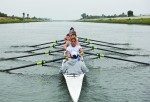Handing her oar off to a teammate, junior Samantha Upton lifted herself out of her boat, over the murky saltwater of Marina del Rey and into the newly vacated seat in the boat floating next to her – in the process sliding past the teammate moving into Upton’s old seat.
Once the two athletes had completed their switch, the two boats pushed away from each other and lined up for a race to determine which boat had improved with its new addition and which was now slower.
When that race was finished and the times for this most recent “seat race” recorded, it was time for two other rowers to make the precarious switch over the marina’s water and into each other’s seats so they too could be compared, and the day carried on in this manner.
After the many switches and races that made up this Saturday practice for UCLA women’s rowing two weeks ago, Upton said she had no idea whether she’d proven herself faster than the teammates against whom she’d been pitted – at least not until the following Monday.
When the team next took to the water, she was no longer in the varsity four. Instead, Upton had worked herself into the more prestigious second eight-person boat, seemingly thanks to a strong showing in her seat race on Saturday.
“You have to be feisty,” she said. “You have to be super competitive and just want it really badly.”
Upton’s competitiveness in her seat race, however, wasn’t the only factor that went into coach Amy Fuller Kearney’s decision to move the junior.
Kearney said she considers everything from performance in the weight room to how athletes interact with the other members of the team when making lineups.
“We’re tracking everything, from every piece we do on the water to every (rowing machine) piece, and use all of that information,” she said. “It’s never as simple as just doing one seat race, that’s just one tool.”
In a sport like rowing, in which it is extremely important that the eight rowers move as one unit and one poorly fitting rower can unbalance the rowing shell, making cohesive lineups can be a long process.
Senior coxswain Mia Hamano says that at UCLA, the process starts with “erg scores,” which measures the athlete’s power output using a rowing machine (an ergometer).
Based on these erg scores, Hamano said Kearney makes a “pairs matrix,” where the top 16 women are matched up into eight two-person boats. The duos train together for a week and then perform time trials of various distances that Kearney records and uses to make new lineups for the next week, at which point the process repeats.
“In the end, I always feel like it’s pretty obvious who should be in the boat,” Hamano said. “There are just always one or two seats where you’re iffy that it could be one (athlete) or the other and in that case I feel like it always comes down to who the rowers want in the boat.”
Kearney also said what an athlete’s teammates think of her can be extremely important in whether or not they make it into a top boat.
“People have to want to pull for you when you get into a boat,” Kearney said. “You have to be someone that people trust.”
